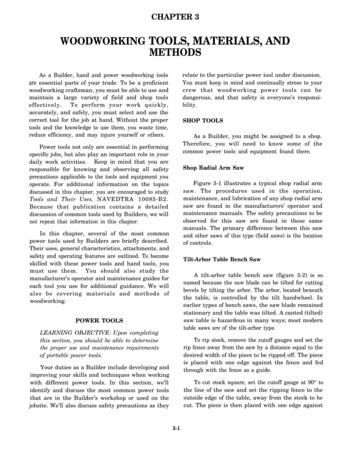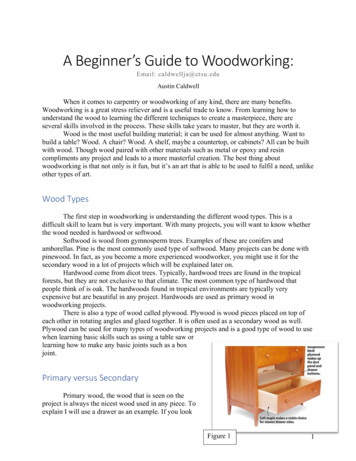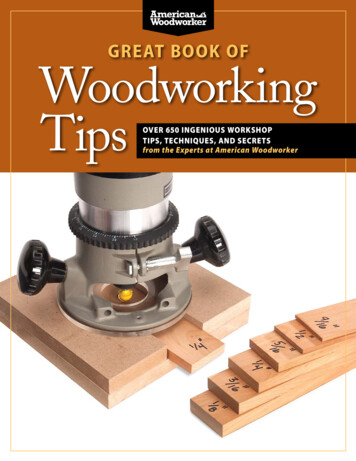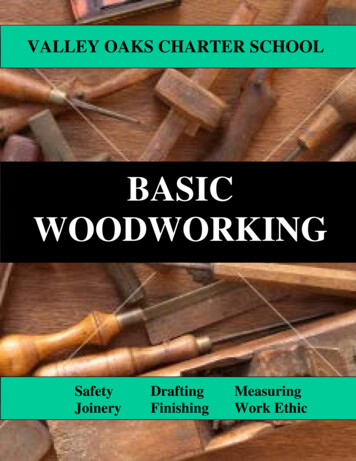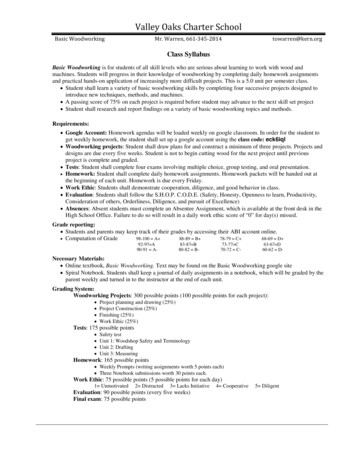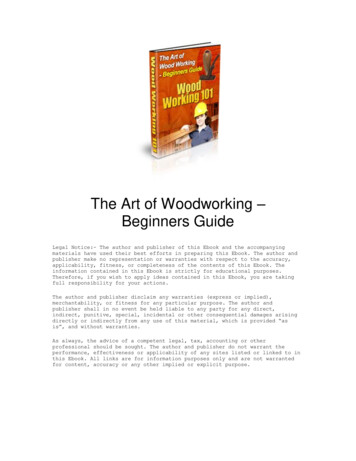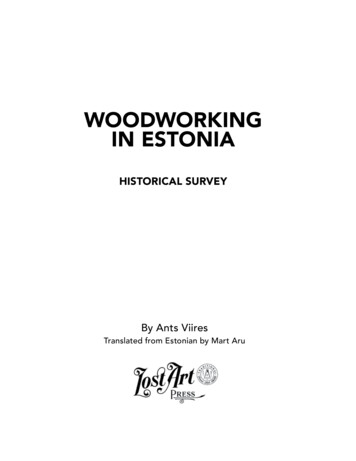
Transcription
WOODWORKINGIN ESTONIAHISTORICAL SURVEYBy Ants ViiresTranslated from Estonian by Mart Aru
Published by Lost Art Press LLC in 201626 Greenbriar Ave., Fort Mitchell, KY 41017, USAWeb: http://lostartpress.comTitle: Woodworking in Estonia: Historical SurveyAuthor: Ants Viires (1918-2015)Translator: Mart AruPublisher: Christopher SchwarzEditor: Peter FollansbeeCopy Editor: Megan FitzpatrickDesigner: Meghan BatesIndex: Suzanne EllisonDistribution: John HoffmanText and images are copyright 2016 by Ants Viires (and his estate)ISBN: 978-0-9906230-9-0First printing of this translated edition.ALL RIGHTS RESERVEDNo part of this book may be reproduced in any form or by any electronicor mechanical means including information storage and retrieval systemswithout permission in writing from the publisher, except by a reviewer, whomay quote brief passages in a review.This book was printed and bound in the United States.
CONTENTSIntroduction to the English Language EditionThe Twisting Translation TaleForeword to the Second EditionINTRODUCTION1. Literature, Materials & Methods22. The Role Played by Woodwork in the Peasants’ Life5WOODWORK TECHNOLOGY1. Timber102. The Principal Tools193. Processing Logs. Hollowing Work and Sealed Containers4. Board Containers965. Objects Made by Bending1276. Other Bending Work. Building Vehicles1487. The Production of Shingles and Other Small Objects8. Turnery1869. Furniture Making and Other Carpentry Work175201DIVISION OF LABOR IN THE VILLAGE1. The Village Craftsman2. Home Industry234FINAL CONCLUSIONS215283Index28781ix1vii
INTRODUCTION TO THEENGLISH-LANGUAGE EDITIONIfeel like Captain Pike. When I was growing up,he was always old. He died at 93 in 1977; I wasmaybe 19 years old. I used to help out around hisplace, shoveling snow, that sort of thing. I got tospend a lot of time with him, usually listening tohis stories while he smoked his pipe on the porch.Many of the stories talked about the old days, theusual “price of a loaf of bread” sort of thing.Now, 40 years later, I delight in telling youngwoodworking students about how it was in “myday” when I was just learning the ins and outsof woodworking. We had no Internet, blogs, forums, social media, etc. – we had to wait for theinformation to dribble our way slowly. I read FineWoodworking magazine from cover to cover,then waited two months for the next issue. Therewasn’t much in between. Most of the books Icould find weren’t really about what interestedme. Some of that changed in 1978 with the publication of John (Jennie) Alexander’s “Make a Chairfrom a Tree” (Taunton Press) and Drew Langsner’s“Country Woodcraft” (Rodale Press).I swallowed those books whole and couldeven quote passages (to myself; no one elsewould listen). By 1981, Roy Underhill’s “TheWoodwright’s Shop” (The University of NorthCarolina Press) was published, and now I hadthree books I could read. Then I would pore overthe bibliographies in these books to find moreinformation. Herbert Edlin’s “Woodland Crafts inBritain” (Batsford) and J. Geraint Jenkins’s “Traditional Country Craftsmen” (Routledge ) were easyenough to hunt down. Both books described theways of English village woodworking, capturedat a time when this life was vanishing.OK, I got those, but what is this other bookthat all three authors mentioned? Langsner citedit as his “favorite” and Underhill as the “most important” along with the Edlin book. “Woodworking in Estonia?” I didn’t even know where Estoniawas in the world. One record said the book waspublished in Jerusalem, by the U.S. government.Huh? It didn’t matter – no bookstore could findme a copy. back when you had to go into thestore. Then the proprietor would somehow contact other bookish types and months would goby before I would get a note saying: “No dice.”Years later, I worked regularly collaboratingwith Alexander, and she generously gave me hersecond copy of this mythical book. Then I sawwhat all the fuss was about. This book shows thehow and why of village woodworking in Estoniaat a time when it hadn’t changed much in a couple hundred years.Now you can see for yourself, and it won’ttake an act of Congress for you to get your copy.As I think about the term we use lately, “greenwoodworking,” I think about the woodworkers recorded here. These were men who knewwood intimately, in ways that often fall shortthese days. They applied their skills at workingand reading wood almost unconsciously: greenwood here, dry wood there. Riven, sawn, straightgrain, curved grain. Steamed and bent, hewnand sculpted. The products featured in the bookare everyday items found in country households,vii
“green woodworking” say he was accustomed toimposing his will on the wood, not letting it havea say in the process. In reading and studying thisbook, you will begin to see evidence of a threeway interaction between an artisan, his tools andthe materials. Then you will be on your way tounderstanding just what these men in mid-20thcentury Estonia were doing as they worked in anage-old tradition, now all but disappeared.As I read through “Woodworking in Estonia”again, it made me want to go make something.Many things. That’s the kind of inspiration I wantfrom a woodworking book. Me, I’m off to scourthe woods for interesting shapes.Peter FollansbeeKingston, MassachusettsOctober 2015FIG. 25. Forked draw knives:1. Draw knife dated 1801, Käina, ERM 426 : 834;2. Draw knife, Äksi, Elistvere, ERM 6939;3. Draw knife, Rõngu, Aakre, EEM 13923.combining utility and beauty in ways that speakvolumes. This book shows us a culture that remained connected to its environment and its traditions long after some others had lost their way.This fine-tuned knowledge is evidentthroughout their work. One example is the hollowing knives (called “forked draw knives”) inthe section on tools and implements. Some ofthese utilize very particular-shaped stock for thehandles. The craftsmen chose a forked section ofa small sapling to connect the two tangs of thisknife into one handle. As visually appealing andquaint as this looks, the purpose was function.A handle made this way follows the fibers of thetree, and is therefore stronger than one madeby bending or joining straight sections of timber. Products such as this show the depth of thecraftsman’s relationship with his materials.While some woodworkers today have thisdegree of tree-knowledge, in general that kindof familiarity between the craftsman and hismaterials is all but lost in the industrialized nations. I recently heard a student who was learningviii
THE TWISTING TRANSLATION TALEOF ‘WOODWORKING IN ESTONIA’Publisher’s note: Ever since being charmed by“Woodworking in Estonia,” I’ve been curiousabout how and why it was first translated intoEnglish in 1969. Fellow woodworkers have sharedstrange theories about the translation with methat involve the U.S. State Department, the Israeligovernment and covert Cold War cash. After myyears as a journalist, I suspected the story wasmore mundane, so I asked researcher SuzanneEllison to dig into the public records availableabout the book and interview surviving membersof the author’s family in Estonia. This is her report.raid drills. They were taught to “duck and cover”under desks or were crowded into school basements with shelves of canned goods lining thewalls. Before being stationed at military bases inWestern Europe, the children of members of theU.S. Armed Forces were issued dog tags in caseof separation from the family.THE GREAT INFORMATION RACE One of theUnited States’ concerns was the perceived gap inscience and engineering education and researchcompared to that of the Soviet Union. A greaterneed for science education and funding led tothe creation of the National Science Foundation(NSF) in 1950. One of the first initiatives undertaken by the NSF was to create a directory ofU.S. scientists, their education, fields of research,location and expertise in foreign languages.Comparisons were made to the known numbersand fields of expertise of scientists in the SovietUnion. The U.S. directory of who was where andwhat they were doing would also be useful in theevent of “mobilization” (i.e. war). In a March 1956report of the Joint Committee on Atomic Energyto the U.S. Senate, the situation was characterized as “in desperate danger of falling behindthe Soviet world in a critical field of competition– the life-and-death field of competition in theeducation and training of adequate numbers ofscientists, engineers and technicians.” Anotherproblem was how to keep track of the massiveamounts of domestic and foreign scientific andtechnological literature being generated andhow to guarantee easy access to it.— Christopher Schwarz, publisher, Lost Art PressIn 1960 a monograph on woodworking is published in the Estonian Soviet Socialist Republic.Within months the book is listed in U.S. government publications. Several years later the bookis being translated in Israel and is listed in a CIApublication. Shades of John le Carré? “Tinker Tailor Soldier Ethnographer?”During World War II, tremendous advanceswere made in science and technology. Longrange rockets, guided missiles and atomic weapons were developed, resulting in an arms race after the war. Western governments and the SovietUnion vied to increase their spheres of influence.For the post-war civilian population, such scientific advances were a cause of fear and anxiety.An American child attending school in the 1950sand into the early 1960s will remember the airix
Then, in October 1957, the Soviets launchedSputnik I, creating a space race and deepeningthe arms race. The capability to put a satellite inorbit also meant an intercontinental nuclear weapon was a possibility. The push to improve scienceeducation and expand research became more intense. The National Defense Education Act waspassed, and the NSF saw its funding tripled. Improved access to scientific literature, both domestic and foreign, became urgent. In the preface to areport by the Quartermaster Research & Engineering Command (January 1959, revised March 1960)it was noted, “It is realized now that if the UnitedStates had translated available information fromRussian publications there would have been nosurprise at the first Sputnik launching. Informationon Soviet earth satellite plans had been publisheda year before the launching in October 1957.”Since World War II the Library of Congress hadbeen collecting Soviet publications to translatethem, and similar efforts were underway in othergovernment agencies, universities and privateindustry. The NSF was tasked with increasing thecollection of foreign language scientific literatureand improving the communication of the availableliterature. The NSF Annual Report for Fiscal Year1957 put it this way: “All the foreign scientific publications which a United States scientist may needshould be readily available to him.regardless ofthe language or nation in which the publicationfirst appeared .The availability of translated, aswell as the foreign publications not translated,should be called to the attention of scientiststhrough publication of English abstracts, a translation collection, announcements .”The need for access to, and exchange of, scientific literature from the countries behind theIron Curtain went beyond the arms race. In anyscientific or technological field of research it is vital to know about related research, controls used,reproduction of results and both failures and successes. Exchanging research and advances inmedicine and knowledge gained in the scienceswas of great benefit for all participants. And if onehappened to come across a clue to a new satellitelaunch, that certainly didn’t hurt.Ants Viires with a brush scythe in 1947, Photoby Veera Puchs. ERM Fk 1907:16.ANTS VIIRES & HIS RESEARCH Ants Viires wasborn in Tartu, Estonia, in December 1918. In 1937he was admitted to the University of Tartu witha focus on language studies. Within three yearsEstonia was caught in a brutal back-and-forth between the Soviets and Nazi Germany. The Sovietstook over in 1944, and Estonia was made a Soviet Socialist Republic and would remain so until1991.In the 1940s Viires shifted his studies to ethnography and began to work at the Estonian National Museum; he graduated from the Universityof Tartu in 1945. At the same time institutions inEstonia were being brought in line to espouseSoviet ideology. Museums and universities became State, as opposed to National, institutions.Researchers were tasked with relating Estonianheritage and culture to that of Russia. Estonianresearchers fled to other countries and somewere purged by the Soviets. Those remaining inthe country were required to be “retrained.” Thex
were needed. Enter the American Foreign FoodAssistance Program and Public Law 480.Public Law 480 (PL 480), otherwise knownas the “Food for Freedom” program, was signedinto law in 1954. The agricultural bounty of theUnited States was a foreign policy tool that wasinitially used to help countries recover after thewar and keep domestic prices from falling. It wasalso a means of discouraging communism. Under PL 480, agricultural commodities could besold to foreign governments for local currencies,donated for famine or emergency relief abroad,or used for emergency situations in the UnitedStates. After a country’s request for aid was approved, the U.S. firms providing agriculturalgoods were paid in U.S. dollars while the importing country paid for the aid in the local currency.Currencies were paid to the U.S. Embassy in thereceiving country. According to the United StateSenate Committee on Agriculture and Forestry,under Title I of PL 480 foreign currencies accruedfrom the sale of agricultural commodities couldbe used among other things “for internationaleducational exchange.for carrying out programs of U.S. government agencies.” Using theprovisions of PL 480 the NSF could set up contracts for translation services in countries receiving U.S. agricultural goods and the services werepaid for with the local currencies accruing at theU.S. Embassies. In 1959 the NSF signed its firsttranslation contract with the Israel Program forScientific Translations (IPST).IPST was formed by the Israeli governmentand employed multi-lingual scientists to translate books and other Soviet-bloc publicationsin chemistry, physics, medicine, biology, mathematics and other fields. Many of the scientists received their education partly in the Soviet Unionand partly in English-speaking countries. The150 or so translators were scientists from the faculties of Hebrew University, the Israeli Institute ofTechnology and research staff of other institutes.By 1964 IPST had translated 330 books and 800articles totaling 110,000 pages. The translatedpublications were printed in Jerusalem and available in the United States through the Office ofSoviets labeled the Estonia National Museum a“nest of bourgeois nationalists.”Viires left the museum in 1946 to pursuepost-graduate studies. From 1949 to 1956 hedid not work in his field of expertise because hiscompulsory work for the German military duringWorld War II was used against him. He worked ina clerical position in a factory in Elva and later asan English and German teacher in a small schoolin Saku. In his free time Viires continued his ethnography studies and wrote his doctoral thesis.He earned his Ph.D. in 1955 and his thesis is whatwe now know as the (unauthorized) 1969 editionof “Woodworking in Estonia.”In 1956, as a result of the “Khrushchev Thaw,”the Soviet Union loosened control of scientificand technological publications, easing the flow ofinformation to the West. As a result, three thingshappened: the Library of Congress increased itsexchange agreements with Soviet libraries, Soviet scientific journals could be readily obtained bysubscription, and U.S.-based dealers could orderbooks through the state book export monopolyMezhdunarodnaha Kniga. To keep up with thetremendous number of Russian-language journals, the NSF gave grants to domestic translationand abstracting services. Materials translated byWestern European groups were also available.Viires was able to work again in his field ofexpertise when he joined the Tallinn Institute ofHistory in 1956. In the July 1957 issue of “EastEuropean Accessions List” of the Library of Congress, a journal article by Viires is listed for thefirst time. Another journal article is listed in theaccessions list in 1958.TRANSLATIONS FOR FOOD Keeping up withthe number of publications that were available toU.S.-based scientists and the time it took for fulltranslations was becoming problematic. Therewere at least 28 academies of sciences and several thousand research institutes in the USSR.Russian-language translations had been givenpriority, but by 1959 the number of non-Russianabstracts and translations had to be expanded.More translations and the money to pay for themxi
The interiors of the two previous editions. The English translation used poorreproductions of the original images. For this new edition, we have obtained theoriginal photos and images from the Estonian publisher.Technical Services of the U.S. Department of Commerce. Complimentary copies of the English editions were sent to the origin countries in the Soviet Union, and IPST also sold editions to 60 othercountries. In 1960 similar translation contractswere signed with groups in Poland and Yugoslavia.In 1960, Viires’ doctoral thesis “Eesti rahvapärane puutööndus: ajalooline ülevaade” waspublished by the Estonian Academy of Sciences.The full publication of a thesis was exceptional inthe Soviet Union. Abstracts and articles summarizing the thesis were required by the author andprinted in limited numbers but were rarely available abroad. It seems despite his “undesirablebackground,” Viires’ work was deemed too important not to be published in full. However, forthis type of publication no royalties were paid. Inthe April 1961 edition of the “East European Accessions List” of the Library of Congress, Viires’monograph was listed for the first time.Through listings in several U.S. governmentpublications, a request for a cover-to-cover translation, the translation of select journal articles, oran abstract could be made. The NSF coordinatedthe requests with various agencies including theAtomic Energy Commission, the National Libraryof Medicine, NASA, the Smithsonian Institutionand the Departments of Agriculture, Commerceand the Interior. Lists of available translated material (with prices) was published regularly. Copies of translated publications were also deposited at the Library of Congress and several majoruniversity libraries.In the case of “Woodworking in Estonia,”the Smithsonian requested the translation fromEstonian to English. Translations by the IPST followed a four-part process with reviews by theeditorial staff, science-area specialists and English-language stylists who were immigrants fromthe United States, South Africa and Britain. Thefirst listing showing the translation was underwaywas in the CIA’s “Consolidated Translation Survey” of January 1968. It was listed under USSREconomics as “Estonian Wood Carving Industry.”Once the translation was completed it was listedin the same CIA publication one year later unxii
tionalize any work and also held a monopoly overthe printing and publishing industries. The “freedom to translate” provision was not abolisheduntil the Soviet Union joined the Geneva versionof the Universal Copyright Convention (UCC) inMay 1973. Joining the Geneva version was chosen to avoid the implementation of the Paris accords of the UCC, which gave authors strongerrights over their work.By 1969 Viires had been studying Estonianlanguage and culture for 32 years. For 29 of thoseyears the Soviets, the Nazis and again the Sovietswere determined to wipe out Estonian identity,language and culture while Viires, working in theconstricts of an occupied country, was just as determined to document and preserve those samethings. According to his family members, Viireswas surprised but pleased his work was translated into English and he added the translationto his bibliography. As Liina Viires, Ants’ daughter, explained, to have one’s work translatedand published abroad was a good thing. Underthe Soviets travel abroad and receiving foreignguests was severely limited and even large areasof Estonia were off-limits. Even though authors inthe Soviet era had little control over their work,the opportunity to have one’s work publishedabroad was a validation and it might open upthe possibility, however slight, to communicationwith one’s peers in other countries.The publication of Ants Viires’ doctoral thesiswas exceptional in the Soviet system. In the 1960ssomeone at the Smithsonian saw in Viires’ monograph the potential for a valuable addition to thehistory of woodworking and folk handicraft, andrequested a full translation. Although the translation was done without the knowledge or permission of the author, it brought this unique recordto the attention of American woodworkers andeventually led to the authorized English translation you are holding today.der Scientific-Miscellaneous as “Woodworkingin Estonia.” The U.S. Department of Commerce,responsible for sales and distribution, provideda full description of the newly translated book inthe “U.S. Government Research & DevelopmentReports” of April 1969. “Woodworking in Estonia:Historical Survey” was described as “Wood, material forming. Culture, USSR. Rural areas, Trees,Small tools, Containers, Bending, Joining, Anthropology, Economics.” Identifiers were: “Socialanthropology, Estonia, Woodworking, Turning(Woodworking), Handicrafts, Furniture.” As wasthe usual practice for an author in a Soviet-controlled country, Viires did not know his Estonianlanguage monograph had been listed in a U.S.government publication, selected for translationinto English, translated by the IPST and madeavailable for sale in the United States. He received four copies of his translated work, but noroyalties.Late in Estonia’s pre-1940 independence period, copyright laws based on the German modelhad been drafted but were not enacted prior tothe Soviet occupation. During the occupationEstonia was subject to the copyright regulationsin the Soviet Civil Codes. The Soviet Union wasnot a member of any international copyright convention until 1973. Prior to this, a work was copyrighted from the moment of creation, not publication, registration was automatic and royaltieswere determined by state-regulated schedules.In the spirit of “the work of one should be for thebenefit of all,” creative output was essentiallyowned by the state. Large portions of a published work could be used without the author’sconsent and using the work of another was notconsidered a theft of intellectual property. Thefirst Soviet copyright laws were in place in 1925,with changes in 1928 and 1961, and each Soviet republic was required to be in compliance.Adding to the lack of an author’s rights was theprovision for “freedom to translate.” This was aholdover from Tsarist laws that allowed a work inRussian to be translated and published in the minority languages of the country without the original author’s consent. The state could forcibly na-Suzanne EllisonChesterfield County, VirginiaJune 2016xiii
2. The Principal ToolsThere is little information about the tools usedin woodworking before the 19th century in theBaltic countries.In the middle of the 17th century Gubertenumerates in his agricultural handbook toolsthat every decent estate should have: “Es istauch nöthig / dass er allerley Zimmermanns-Instrumente halte / damit er sie nich in der Nachbarschaft mit Hin- und Wiederschicken suchendörffte / : nehmlich ein Holtz und breit Beil,Szuillex,1 eine starcke Hand-sage / Norkken- undBalkensage2 dreykantichte Pfeile / die Sagen zuscharffen / mit vierkantichten oder plat Feilen kanman sie nicht scharffen. Aber zur Balkkensage dienen die Platfeilen /ein grosser Bohr zu den Treppen oder Leitern nötig. Item ein Bohr eines Daumens dikk / ein kleiner Bohr den Harkken / einZwingbohr / ein Schneidemesser / ein Lizing3 wiedie Bötcher gebrauchen / zu den Trögen nöhtig/ eine Zerpe,4 damit man Bakk-Viehe-Tröge undMulden machet / eine gute sharffe und stumpffeKniepzange / Hammer und Durschlage.”5As we see, the list contains a number of typesof axes, a handsaw, bucksaw, a log saw, saw files,boring tools of several sizes, a cutting knife,a carving knife, a scooping axe, etc. The omission of a plane is noteworthy (presumably overlooked). Also of interest is the mention of largesaws. Both these tools appeared in the village ata much later date.The next more or less comprehensive list oftools is known from Estonia, but from a farm instead of an estate. A. Holter, a peasant from theneighborhood of Pärnu and the year 1818: “Thefarmer who is also good at handicraft has threegood saws, three of four planes and two longplanes, as well as some chisels and a brace anddrill. He also has two or three working knives aswell as two or three benches on which he can dohis work. He also has a drawing and a hollowing knife by which he can make all the utensilssmooth inside and out.”6 The text itself describesa master woodworker whose collection of toolswas far more complete than that of an ordinarypeasant, particularly as concerns planes andsaws. Apparently that is why the axes are notmentioned; they are thought of as too-ordinaryand everyday tools. In the same publication, butin another context it has been mentioned that every peasant had from six to seven axes.7Here is one more note from 19th century Saaremaa where the old ways survived longer thanon most of the mainland: “What woodworkingtools there were in olden times – axe, knife, oneor two chisels, a handplane, a rip saw, and if therewas also a brace and bit, that was all. He who hada carpenter’s bench and a few planes as well assome little saws, too, was already a master.”8So the principal woodworking tools in Estonian villages were axes, knives, hollowing and1Lt zuleksts “carpenter’s axe:“ The word has been used inLatvian mainly in the XVII century (Sehwers, p. 217).2Bsks Norkensage “corner saw, two-man saw” (bsks Norke enurk (corner) see Kiparsky, p. 57).3Lt lizenis “spokeshave” (Bielenstein, p. 340).4Lt zērtnis, zērknis “scooping axe” (Bielenstein, p. 322).5Gubert, pp. 7-8 translation: “It is also necessary that he shouldhave various carpentry tools, so he need not look for them inthe neighborhood , namely a chopping axe, a broad axe,carpenter’s axe, a strong handsaw, a corner and a crosscutsaw, triangular files for the sharpening of saws, because theycannot be sharpened with quadrangular four-sided or flat files.But the pit saw needs wider files. A large auger that it is necessary for stairs or for ladders. Also an auger the thickness ofthe thumb, a small rake borer, a gimlet, a drawknife, a drawingknife, a bucksaw, a carpenter’s hollowing knife, which coopersfind necessary for making troughs, a (cross-axe/trough axe)with which (necessary for troughs) bread and animal troughsare made, good sharp and blunt tongs, a hammer andpunches (perhaps chisels).”6Beiträge XI, 1818, p. 33.7Ibid, p. 28.8KV 34, 532 Pöide.
20WOODWORKING IN ESTONIAdrawing knives, augers, chisels, saws and planes;of these the latter were mainly in the hands ofwoodworkers. In this chapter we will give a historical overview of the main groups of objects,finally dwelling on some more general resourcesand also on workrooms. We will look at specialtools for various other special works separately,along with the observation of the respectivetechnical procedures.a. Hatchets and AxesThe importance of the hatchet and the axeas universal tools was maintained in the farmers’woodwork right through the medieval period.In Estonia numerous special factory-made toolsthat appeared on the market in the second half ofthe 19th century seriously reduced duties of theaxe. Before the introduction of the saw into forestry work, which took place in the third quarterof the 19th century, most wood cutting and chopping was done by the axe. The pit saw, which appeared about the same time, largely ended splitting of logs into boards by means of the axe andwedges. Extensive spread of planes considerably narrowed the earlier practice of smoothingsurfaces with the axe, which did not yield muchpoorer results in case of careful work.As in the development of tools in general,so also the hatchet and the axe followed a pathof specialization in the course of their history. Intheir case, however, the greatest variety in theiruse was reached toward the end of the feudalperiod. Thereafter they were replaced by other, more suitable tools. This development tookplace primarily among artisans. The variety ofaxes used by the farmer has always been morelimited.The history of the development of types ofaxes in the prehistoric period has been relativelywell studied, but the further development of theaxe has been rather deficient. Ethnographersand archaeologists have only touched upon theissue in passing. Although the Estonian NationalMuseum has more than 100 field finds of variousaxes from different periods, they are largely veryloosely dated. Consequently, it is possible to discuss the history of the development of the axeFIG. 1. Parts ofthe axe.only in very general terms.Before going more fully into this development of the axe, it would be useful to acquaintourselves with the terms denoting the parts ofthe tool. These are generally identical with theparts as known all over the world, adapted bothin language and in application to use in Estonia.The Estonian word “kirves” (axe) is of thesame origin as all West Baltic and Finnish terms(Latvian “cirvis,” Lithuanian “kirvis”).The axe (see Fig. 1) consists of two main parts— the head (I) and the blade (II). The head contains the eye, which is usually a triangular aperture (1), serving for the insertion of the handle.(In western Estonia the handle was kn
woodworking students about how it was in “my day” when I was just learning the ins and outs of woodworking. We had no Internet, blogs, fo-rums, social media, etc. – we had to wait for the information to dribble our way slowly. I read Fine Woodworking magazine from cover t

